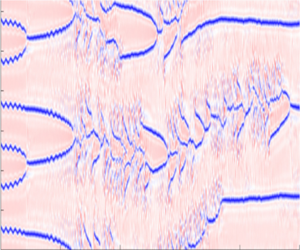Published online by Cambridge University Press: 08 August 2022

Recent experiments have reported a novel transition to elasto-inertial turbulence in the Taylor–Couette flow of a dilute polymer solution. Unlike previously reported transitions, this newly discovered scenario, dubbed vortex merging and splitting (VMS) transition, occurs in the centrifugally unstable regime and the mechanisms underlying it are two-dimensional: the flow becomes chaotic due to the proliferation of events where axisymmetric vortex pairs may be either created (vortex splitting) or annihilated (vortex merging). In this paper, we present direct numerical simulations, using the finitely extensible nonlinear elastic-Peterlin (FENE-P) constitutive equation to model the polymer dynamics, which reproduce the experimental observations with great accuracy and elucidate the reasons for the onset of this surprising dynamics. Starting from the Newtonian limit and increasing progressively the fluid's elasticity, we demonstrate that the VMS dynamics is not associated with the well-known Taylor vortices, but with a steady pattern of elastically induced axisymmetric vortex pairs known as diwhirls. The amount of angular momentum carried by these elastic vortices becomes increasingly small as the fluid's elasticity increases and it eventually reaches a marginal level. When this occurs, the diwhirls become dynamically disconnected from the rest of the system and move independently from each other in the axial direction. It is shown that vortex merging and splitting events, along with local transient chaotic dynamics, result from the interactions among diwhirls, and that this complex spatio-temporal dynamics persists even at elasticity levels twice as large as those investigated experimentally.